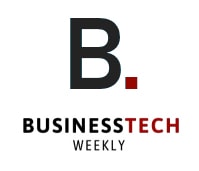IT Governance Models: Frameworks and Best Practices

IT governance models provide you with the tools to align technology usage with business objectives, all while maximizing compliance, efficiency, and risk management effectiveness.
These IT governance models inform you on the decision-making processes, roles, and accountability needed across your IT landscape.
Popular frameworks such as COBIT and ITIL offer scalability for SMEs and corporations, addressing diverse needs like performance monitoring or data security.
Grasping these models is key to making your way through today’s intricate digital landscape and reaping the strategic value that they can offer your operations.
On this page:
- What is IT Governance?
- Why Implement IT Governance?
- Who is Responsible for IT Governance?
- Exploring Common IT Governance Frameworks
- Popular IT Governance Models
- Tailoring IT Governance to Your Organization
- Integrating Risk Management and Compliance
- Common Pitfalls to Avoid
- IT Governance in Agile and DevOps
- Future Trends in IT Governance
- Key Points to Note
What is IT Governance?
IT governance isn’t just a buzzword, but rather a structured framework that helps focus all IT investments, activities and operations on advancing an organization’s overall mission and goals.
It helps align technology strategies to business goals, drive accountability and transparency across multiple IT processes.
In this sense IT governance is an important foundation of enterprise governance.
It ensures that organizations can continue to manage the growing demand to drive technological innovation and successfully translate IT performance into their strategic objectives.
Defining IT Governance Simply
Simply put, IT governance is the established procedures and processes that are defined and enforced to simplify decision-making across IT operations.
In the 1990s, it evolved as a critical evolution of corporate governance.
The goal was to increase transparency and accountability just as the private sector became highly dependent on technology.
IT Governance models or frameworks govern the overall IT decision-making process. They address accountability, deter waste and abuse, and enhance the performance of government.
At its core, robust IT governance models create repeatable workflows to prevent risks like regulatory non-compliance, security exposures, or resource waste.
For instance, practices like ITIL (IT Infrastructure Library) focus on aligning IT services with business needs, while frameworks like TOGAF guide enterprise information architecture planning.
This level of clarity goes a long way in building trust between decision makers and stakeholders, keeping IT operations transparent.
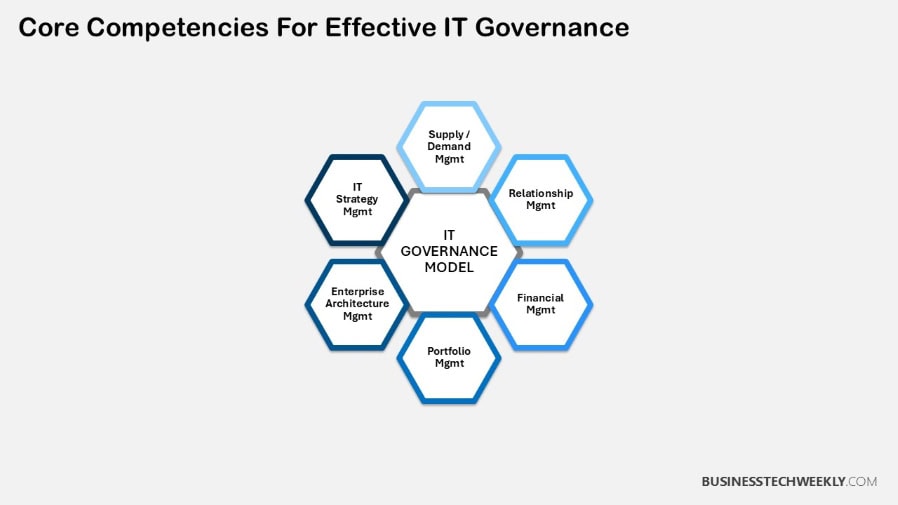
Why IT Governance Matters Now
The rapid pace of technological advancements has made robust IT governance more critical than ever.
As technology integrates deeper into business operations, frameworks that address complexity become indispensable.
IT governance encompasses disciplines such as compliance assessments, incident resolution, and security training, equipping organizations to adapt to evolving demands.
Regulatory compliance further emphasizes its growing importance.
IT Governance models like the NIST Cybersecurity Framework offer clear policies for private sector organizations to counter cyber threats, meeting both legal requirements and stakeholder expectations.
Given that 80% of organizations have already adopted governance models, the need to implement these practices in today’s environment goes without saying.
IT Governance Models and Business Success
Smart IT governance models drive better business outcomes by closely aligning technology investments with strategic priorities.
For instance, publicly traded companies frequently use governance as a means of financial accountability and operational efficiency.
Frameworks such as ITIL improve service management, allowing organizations to be more agile and responsive to changing market environments.
Implementing IT governance leads to better resource allocation and utilization, contributing to operational efficiency and cost reduction.
Why Implement IT Governance?
IT governance is more than just a pretty framework; it represents a strategic commitment to aligning technology with business goals, maximizing value creation, and minimizing information risks.
The ugly truth is that businesses are facing increased exposure to operational risk as their success becomes more dependent on technology governance.
To maintain accountability, enhance performance, and drive innovation, robust governance structures must be established.
Strategic Alignment Benefits
IT governance models help make certain that all technology initiatives are directly in support of the organization’s business objectives.
It helps establish a clear link between IT initiatives and business objectives.
By synchronizing IT plans with overall enterprise strategy, organizations can remove duplicative initiatives and direct effort towards projects that matter most.
For example, a retail organization can create greater efficiency in its e-commerce initiative by implementing IT governance.
The end result of aligning closely with revenue targets is improved customer experience and increased sales.
Strategic alignment improves organizational performance by ensuring that technology is seen and treated as a key enabler of business success, not an isolated function.
Value-Driven IT Operations
Ensuring optimal value from all IT investments is an essential tenet of good governance.
By establishing standardized practices, organizations will see increased efficiency and cost-savings across IT operations.
For example, a healthcare provider implementing IT governance could optimize its electronic health record system, reducing operational costs while improving patient data accessibility.
Value-driven IT operations contribute to stakeholder satisfaction by demonstrating a clear return on investment and ensuring that technology decisions meet both internal and external expectations.
Improved Resource Management
Effective IT governance allows for more effective and efficient use of resources, making sure technology investments go to the best possible projects.
By ensuring that resources are allocated in alignment with overall strategy, organizations can increase the likelihood of project success and cut waste.
Take a financial services company that values governance. Their firm can afford to spend more resources to improve their cybersecurity.
This method reduces potential vulnerabilities risk while operating within budget limitations.
This strategy contributes to improved operational efficiencies and makes sure that investments in technology are maximized.
Enhanced Risk Mitigation
IT governance is essential in order to define and discover areas of risk.
It’s a game changer when it comes to security, compliance, and data protection.
Risk mitigation protects organizational properties and assets.
Proactive risk management protects the property of the organization while assuring compliance with regulatory directives, like the Sarbanes-Oxley Act.
An organization that adopts IT governance can establish procedures to prevent these data hacks from occurring.
By taking this proactive approach, the organization helps protect its reputation and avoid financial calamity.
Performance Measurement Advantages
Performance measurement is becoming an indispensable part of determining and ensuring effective IT governance.
By tracking key metrics, such as project delivery timelines and cost savings, organizations can evaluate their success and identify areas for improvement.
Ongoing performance review keeps governance flexible and focused on changing business requirements over time.
Organizations with robust IT governance structures experience increased innovation and flexibility.
Who is Responsible for IT Governance?
Strategic IT governance must be a team effort, with well-articulated but overlapping responsibilities between essential stakeholders.
This fosters an environment where technology investments not only support broader business goals but maximize value potential and minimize risks.
From creating a new culture of accountability and broad stakeholder inclusivity, organizations can develop the necessary governance model to steer toward ethical practices, innovation, and long-term success.
Board and Executive Leadership
It is board members and executive leaders that set the stage as a more fundamental bedrock of IT governance.
Their main role ought to be defining strategic priorities, making sure that IT initiatives serve the larger business goals.
We know that leadership commitment makes the difference between equitable success or failure for many governance frameworks.
When senior executives participate in IT governance initiatives, they show that these initiatives are important across the enterprise.
This degree of support establishes an environment of accountability and improvement. Sustained engagement is just as important.
Frequent conversations around IT’s performance, risks, and opportunities equip agency leadership to make the best possible decisions.
These go beyond technology improvements to include better resource allocation, faster compliance, and risk mitigation.
The Chief Information Officer (CIO) works in very close coordination with the board. Jointly, they bear the burden of walking the fine line of ensuring strategic oversight while executing operationally.
IT Steering Committee Roles
The IT steering committee is needed to help connect the dots between a system’s leaders and its operational teams.
Its role is to provide a governance umbrella over governance activities, and that includes prioritizing projects and IT resources so they’re allocated where needed most.
By appointing a varied group of representatives—including IT staffers, business unit heads, and risk management executives—the governance committee promotes holistic viewpoints.
This diversity makes for better decision-making, especially when weighed against cohesive, complex, major issues facing the organization such as cybersecurity and data privacy.
Steering committees are crucial for tracking performance. They drive IT investments to their measurable return which aligns with organizational strategic objectives.
The Role of IT Professionals
IT professionals play a vital role in supporting and implementing governance practices.
So, beyond the tools and processes they manage and implement, they play a critical role in helping align technology with strategic organizational goals.
Those professionals certified by organizations such as ISACA have a wealth of knowledge and experience. They are smart on risk management and ITIL principles.
Ongoing training keeps them fresh on emerging technologies and regulatory changes, allowing them to be more proactive than reactive.
By bridging technical know-how with business acumen, IT teams ensure their position as strategic partners.
Shared Responsibility Model
The shared responsibility model further underscores the importance of collaboration across every department.
By redistributing the accountability this way, this method creates an assurance that IT governance is a group activity.
For instance, though the CIO is responsible for execution, other departments are required to structure their operations to conform with governance requirements.
Shared accountability increases transparency, fostering innovation and ethical practices.
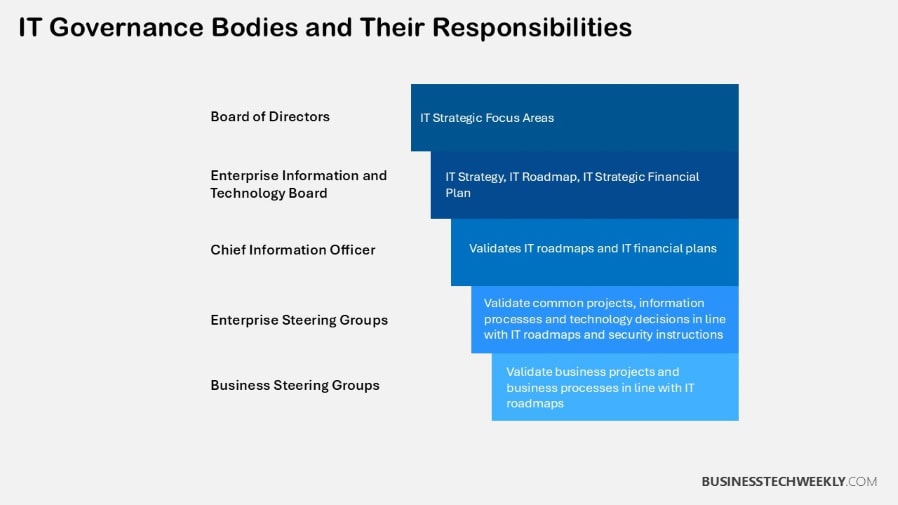
Exploring Common IT Governance Frameworks
IT governance frameworks offer organizations structured approaches to managing IT resources, mitigating risks, and ensuring compliance with industry regulations.
It’s hard to overstate how important technology is to business operations today.
Consequently, these IT governance models have become indispensable resources for aligning IT initiatives with broader organizational objectives.
Choosing the appropriate framework is vital, for it determines how your organization lays the groundwork for standardizing governance practices and managing risks in a meaningful way.
1. COBIT: A Comprehensive Overview
ISACA’s framework, COBIT, is arguably the most well-known framework for IT governance.
The newest iteration, COBIT 2019, takes the foundation laid by COBIT 5 and provides more relevant and current guidance to meet the contemporary enterprise IT landscape and hurdles.
COBIT is uniquely suited to help close the pesky gap between IT and business, working to align technology objectives with broader organizational goals.
Its focus on balancing risks management with value generation is what makes it essential for enterprises, particularly large enterprises, who operate in heavily regulated industries.
Key components, including governance system design, priorities cascade, and performance management toolbox, provide tangible guidance for leaders to implement smart governance.
This provides significant value for enterprises seeking meaningful, formal governance—making COBIT invaluable.
2. ITIL: Focusing on Service Management
The ITIL framework emphasizes best practices for IT service management, prioritizing the delivery of high-quality IT services.
Because of its universal adoption, ITIL acts as a standardization for IT’s operations, aiding in increased efficiency, effective service delivery, and repeatability.
Industries reliant on service delivery, such as healthcare and financial services, often leverage ITIL to improve customer satisfaction and operational outcomes.
By integrating ITIL with other frameworks like COBIT, organizations can achieve a more comprehensive governance strategy, ensuring both service quality and compliance.
3. ISO 38500: Principles-Based Governance
Best known for its principles-based approach, ISO 38500 delivers a governance strategy that emphasizes accountability, transparency, and alignment with organization strategy.
Moreover, its guidance supports organizations in establishing efficient governance practices as well as maintaining alignment with global standards.
Compliance with ISO principles increases credibility, which can be especially useful for organizations operating in complicated regulatory environments.
4. COSO: Internal Controls Framework
The COSO framework focuses on internal controls and risk management, providing a strong basis for enterprise IT governance.
Its flexibility makes it possible to incorporate it with other frameworks, including COBIT, to cover more extensive governance requirements.
By emphasizing compliance and accountability, COSO provides a framework through which organizations can ensure operational integrity and regulatory compliance.
5. CMMI: Process Improvement Approach
CMMI, or Capability Maturity Model Integration, focuses on process improvement and capability development.
Its systematic framework allows organizations to measure their maturity and pinpoint where they need to improve, driving ongoing development and evolution.
CMMI is especially well-suited for organizations looking to create more automation, enhance efficiency, and improve production continuity.
6. FAIR: Quantifying Risk Management
The FAIR model provides a quantitative advantage to IT risk management that is rapidly gaining adoption among organizations who increasingly are putting a premium on cybersecurity.
FAIR allows large corporations to identify and predict risks while establishing clear priorities for risk mitigation strategies.
By quantifying risk, FAIR empowers informed decision-making, making it a critical framework for modern enterprises.
Popular IT Governance Models
Model |
Focus Area |
Key Benefit |
Best For |
| COBIT | Aligning IT objectives with business goals, balancing risk and value generation | Helps close the gap between IT and business, essential for regulated industries | Large enterprises in regulated industries |
| ITIL | Best practices for IT service management and operational efficiency | Improves service delivery, efficiency, and repeatability, especially in service-heavy industries | Industries relying on service delivery, like healthcare and finance |
| ISO 38500 | Principles-based governance emphasizing accountability and transparency | Supports alignment with global standards, enhances credibility in regulatory environments | Organizations seeking credibility and compliance with global standards |
| COSO | Internal controls and risk management for operational integrity | Ensures compliance and accountability, adaptable to other frameworks like COBIT | Organizations needing strong internal controls and risk management |
| CMMI | Process improvement and capability development, focusing on maturity | Enables continuous improvement, enhances efficiency and production continuity | Organizations focusing on improving processes and operational maturity |
| FAIR | Quantitative risk management and decision-making in cybersecurity | Provides quantitative risk assessment, empowers informed risk mitigation decisions | Enterprises focusing on cybersecurity and risk mitigation |
Implementing IT governance ensures that IT investments are strategically aligned with business objectives, optimizing risk management and resource utilization to support the organization’s mission and goals.
Tailoring IT Governance to Your Organization
Tailoring IT governance models to the unique needs and objectives of the organization is crucial for fostering practical and long-term outcomes.
IT governance first emerged in the 1990s as a means of improving corporate governance. It is intended to improve accountability and transparency in IT system management.
Today, it serves as a strategic tool for businesses to balance risk, performance, and compliance, particularly as digital transformation reshapes industries.
By customizing your IT governance efforts, you ensure that technology initiatives support your overall business strategies, driving operational efficiency and innovation simultaneously.
Assess Current IT Maturity
Understanding your current IT maturity is a critical first step. This involves evaluating existing capabilities, processes, and gaps.
Tools like COBIT maturity models or ITIL assessments provide structured methodologies for this evaluation.
For instance, COBIT offers insights into IT risk management and value delivery, while ITIL focuses on service strategy and continual improvement.
A thorough assessment highlights areas like data retention, risk mitigation, and disaster recovery readiness, forming the foundation for effective governance.
Define Clear Objectives and Scope
Establishing specific goals will help make certain that your IT governance efforts are in sync with overall business objectives.
For example, a healthcare organization might prioritize compliance with data protection laws, while a retail company may focus on enhancing customer experience through seamless IT operations.
Identifying the scope—whether it’s service design, a backlog or crisis mitigation—determines how and where to focus resources.
By engaging stakeholders early, you can build shared ownership and agreement on what success looks like.
Select the Right Frameworks
Selecting the right frameworks is a consideration for any organization, requiring attention to industry standards, organizational culture, and needs.
COBIT and ITIL are two of the most adopted IT governance models and provide a very complementary approach.
While COBIT strives to align with enterprise risk and strategy, ITIL strives for operational excellence.
When put together, these frameworks form a strong governance model that can be shaped to fit your specific context.
Develop Governance Policies
Formal policies and practices can help to ensure IT governance provides the needed structure, consistency, and accountability.
Crucial aspects are ensuring there are clear roles, transparent procedures and requirements for compliance.
One example is a policy on service operation, which can spell out standard operating procedures for managing incidents, so that your teams respond consistently.
Establish Key Performance Indicators (KPIs)
KPIs are a way of measuring how effective your governance actually is.
Metrics such as service availability, compliance improvement, or risk mitigation are oriented toward the organization’s mission.
Tracking these on an ongoing basis helps level up to a practice of continuous improvement.
Communicate and Train Stakeholders
Strong communication across your organization is essential for cultivating a culture of robust governance.
Training programs and DAPs (digital adoption platforms) like Whatfix can assist users in navigating systems or new governance workflows.
Regularly Review and Adapt
Governance frameworks need to change as the business changes.
Ongoing monitoring and input from stakeholders make it flexible to meet changing priorities.
For sustained success, continuous improvement must become number one on the list.
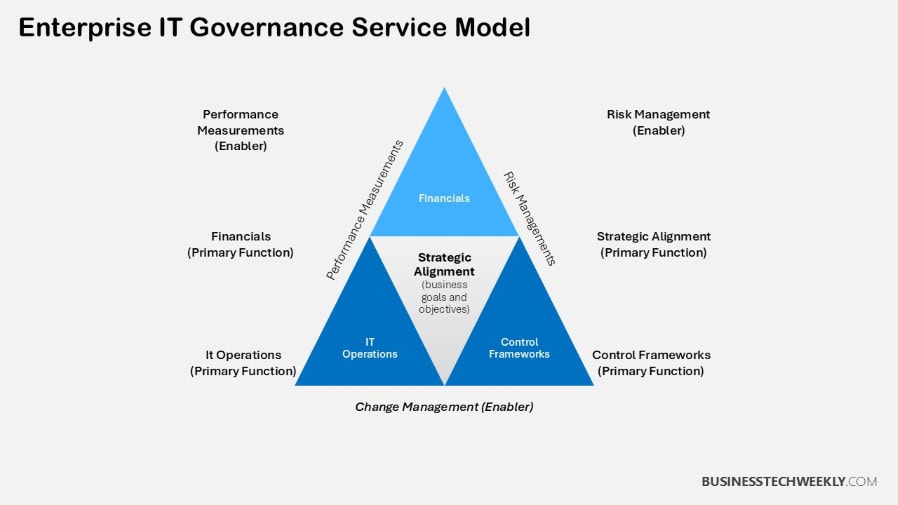
Integrating Risk Management and Compliance
Integrating risk management and compliance into broader IT governance is critical to cultivating a strong, accountable, and resilient organization.
This integration ensures that businesses not only meet regulatory requirements but proactively address potential threats, enabling smoother operations and bolstering stakeholder confidence.
By integrating risk management and compliance governance frameworks, organizations can effectively streamline processes in managing compliance risks.
This streamlined approach gives them more capacity to focus on compliance.
Identifying IT-Related Risks
Sound risk management begins with understanding and prioritizing IT-related risks.
These include incidents such as data breaches and ransomware attacks, and extend to system failures and even third-party vulnerabilities.
For instance, a financial services firm might face risks like unauthorized access to sensitive customer data or compliance challenges with evolving regulations like GDPR.
By leveraging security automation and AI-driven analytics, businesses now have an opportunity to proactively uncover vulnerabilities and risk areas.
This stops these minor troubles from growing into major catastrophes.
This forward-looking approach builds on governance initiatives and creates an enabling environment for future resilience.
Implementing Control Measures
Once risks are identified, implementing control measures is essential.
Organizations can adopt preventive controls like multi-factor authentication, detective controls such as automated continuous monitoring, and corrective controls, including incident response plans.
For example, a healthcare organization subject to HIPAA may employ a GRC platform to track compliance tasks, automate monitoring, and manage third-party risks.
Regular evaluation of these measures ensures their effectiveness in mitigating risks and adapting to emerging threats.
This ongoing refinement ultimately minimizes disruptions and maintains operational integrity.
Ensuring Regulatory Compliance
Staying one step ahead of regulatory compliance is a key governance imperative. Frameworks such as ISO 27001 and GDPR provide a roadmap to organizations.
They assist in ensuring that IT practices conform to minimum legal and ethical expectations.
Governance supports this alignment by putting in place centralized compliance initiatives powered by platforms that enable automated processes to minimize the need for manual input.
The risks of non-compliance can be severe, including expensive penalties, reputational harm, and operational delays.
This further underscores the importance of taking a strategic, compliant, and purposeful approach.
Monitoring and Reporting on Risk
Creating open and understandable processes for monitoring and discussing risk increases transparency and can help foster trust with stakeholders.
A centralized GRC hub provides the capabilities to assign and track tasks and deliver alerts and notifications, ensuring that risk-related information gets communicated in a timely manner.
Regular reporting ensures accountability and supports informed decision-making, reinforcing the organization’s ability to respond effectively to evolving challenges.
Research indicates that IT governance has a significant positive effect on financial performance.
Common Pitfalls to Avoid
Developing robust IT governance is perhaps the most important part of ensuring that technology initiatives are aligned with business goals and effective workflow governance.
Despite this, organizations often stumble in executing a successful community engagement program.
By focusing on structured governance processes, you can avoid these pitfalls and create a governance framework that is as flexible as it is durable.
Ignoring Business Alignment
One of the most profound risks in IT governance is not managing IT governance with business strategies.
When IT is the only actor operating in a vacuum, the outcome is costly redundancies, ineffective deployments, and missed opportunities for growth.
For instance, an organization may invest in advanced AI tools without understanding how they support its core objectives, leaving these tools underutilized.
An ongoing conversation between IT and enterprise business leaders helps make sure that governance decisions are always aligned with the organization’s priorities.
When IT strategies are informed by the overarching mission, governance is transformed into a driver for innovation instead of a disconnected process.
Treating Governance as an Afterthought
Many organizations push governance to the backburner, opting to focus on operational requirements as a higher priority or considering governance a second-class concern.
This ad hoc approach often invites inefficiencies and creates new vulnerabilities.
Proactive governance planning means engaging legal and compliance teams from the start.
Doing so will help make sure that policy decisions are compliant with industry regulations including GDPR.
Good governance fosters more than just robust risk management, but strong organizational efficiency as well, allowing you to free up resources and put them toward long-term growth.
Lack of Visibility into IT Operations
Poor visibility into IT operations undermines governance through a lack of accountability and informed decision-making.
Without this visibility, issues such as shadow IT or a poorly allocated budget are hidden from view.
Using technology, from monitoring dashboards to advanced analytics tools, improves operational awareness and insights.
When deployed correctly, these tools offer the ability to ground decision-making in real-time data, allowing leaders to prioritize strategic, evidence-based choices.
Misalignment with Enterprise Governance
IT governance must not operate in a vacuum apart from the overall enterprise governance frameworks.
This misalignment risks leaving accountability gaps and gaps in strategic coherence.
Additionally, siloed IT governance can directly undermine company-wide compliance initiatives, for example, putting the entire organization at risk of legal liability.
A cohesive and thought-out governance structure allows for uniformity and strengthens the overall goals of the organization.
Overlooking Internal Threats
Internal threats, such as insider breaches, have increasingly become a concern for organizations.
These events average $644,852 per occurrence in direct costs to companies.
Mitigating these risks often goes beyond the technical fix, and building an organizational culture that promotes security awareness is key.
That’s why regular audits and well-defined policies are the best defenses against these insider threats.
Neglecting End-User Training
IT governance is only going to be successful if end-users are brought into the fold. Without appropriate training, they can easily and unwittingly undermine OGP’s pro-governance principles.
Employees who are not trained on the dangers of phishing are likely to put sensitive data at risk.
Continuous models of training, customized to changing threats, better educate and engage users, leading to more effective governance results.
Poor Data Quality
Strong governance can only go so far without robust data to inform it.
Without accurate and reliable data, the best decision-making can go off the rails, leading to flawed forecasts and unnecessary expenditures.
By treating data as an asset instead of a byproduct, we can make sure that information is consistent, reliable, actionable, etc.
By building data quality management practices like validation protocols and regular audits into the governance framework, data quality is strengthened.
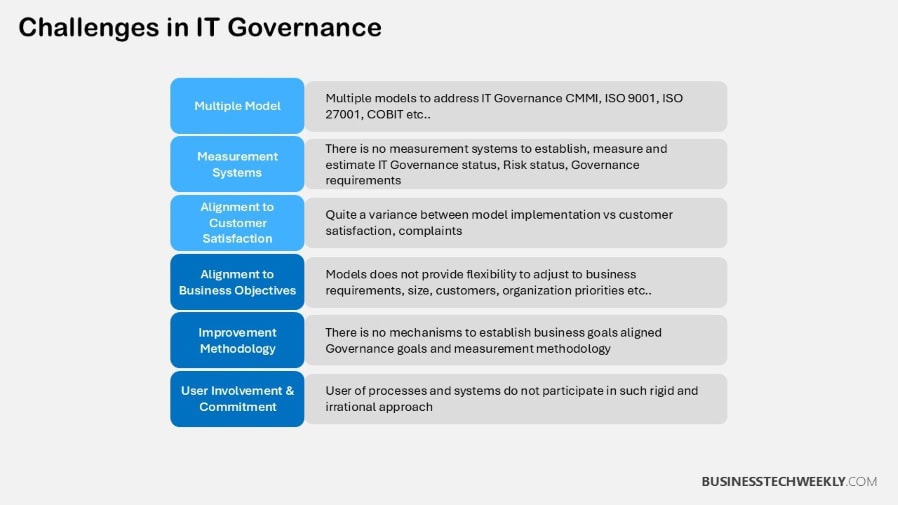
IT Governance in Agile and DevOps
The adoption of Agile and DevOps methodologies brings tremendous risks associated with this powerful force for IT operations innovation, efficiency, and collaboration.
These frameworks have tested traditional and antiquated IT governance frameworks.
Organizations need to challenge their old ways to better fit with business goals and at the same time promote agility and velocity.
Ensuring that compliance, security, and innovation are prioritized equally is key to good governance in such agile and rapid offices.
Adapting Governance for Agile
Aligning IT governance practices with Agile means moving away from rigid structures in favor of those that embrace flexibility.
Agile excels through short iterative development cycles and abundant feedback, so governance needs to accommodate and promote quick decision-making while ensuring adequate oversight is maintained.
Standardized approval processes and transparent escalation paths allow teams to keep their pace without veering off course from broader organizational objectives.
This is why creating cross functional teams is fundamental to keeping governance efficient and effective when transitioning to Agile.
Having a seat at the digital table by including representatives from IT, business, and compliance teams, organizations can weave governance into daily operations.
Metrics such as burndown charts and cumulative flow diagrams (CFDs) are incredibly useful for transparency.
They make everyone easily informed and empower stakeholders to monitor progress and assure alignment with objectives.
Training and coaching is often needed to overcome pitfalls, especially for teams not experienced with Agile governance concepts.
Integrating Security into DevOps (DevSecOps)
DevSecOps integrates security practices into the DevOps pipeline, ensuring that governance incorporates proactive risk management.
By embedding security checks into every stage of the development lifecycle, organizations can address vulnerabilities early, reducing the likelihood of costly breaches.
Automated tools like code scanners and vulnerability assessment software streamline these processes, enabling teams to maintain compliance without hindering productivity.
With the implementation of any third-party tools, such as ChatGPT, active security measures should be implemented proactively.
IT governance policies should reflect the risks involved in AI, including safeguarding data privacy and fostering ethical usage as top priorities.
In the process, it maintains an organization’s integrity, fosters trust, and protects the organization’s business.
Automation and Continuous Monitoring
Automation isn’t just the superhighway to modern IT governance—it’s the foundation itself, especially in environments ruled by Agile and DevOps.
By automating compliance checks, policy enforcement, and reporting, it’s not just a time-saver—human error is reduced, too.
Continuous monitoring solidifies governance by enabling organizations to have real-time insights into their system’s performance, security, and risk management.
Using integrated risk management platforms can provide the wide-range oversight needed, making sure IT operations are synchronized with the organization’s overall business strategy.
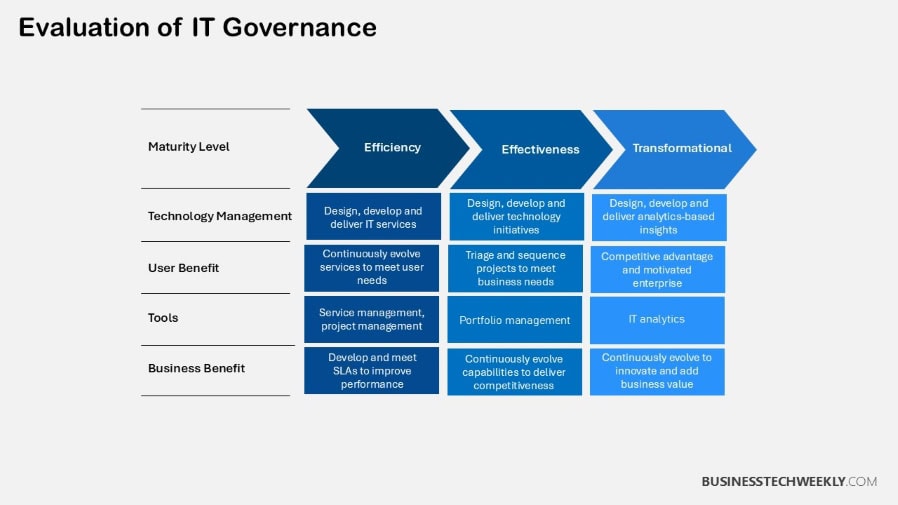
Future Trends in IT Governance
The landscape of IT governance is changing at an unprecedented pace. Technological innovations combined with ever-evolving organizational needs have fueled this transformation.
As enterprises embrace these technologies, their IT governance models need to change, too, to meet new challenges and opportunities.
Keeping ahead of these trends will be critical for continuing to provide effective governance and ensuring the long-term success of IT.
Cloud Governance Considerations
With federated, multicloud environments, traditional governing IT in the cloud can come with complex challenges.
Cloud platforms provide unrivaled scalability and flexibility, making them a necessity in today’s hyper-accelerated market.
These benefits introduce challenges in data security, access management, and compliance.
Developing consistent cloud governance policies allows organizations to maximize the value of their resources and minimize risks.
Establishing clear ownership for determining access permissions and actively monitoring shared environments can help mitigate risk.
Continuing a routine and systematic evaluation of cloud governance readiness is just as critical.
They help organizations identify gaps, adapt to evolving regulations, and leverage the full potential of cloud solutions without compromising security.
AI and Automation Impact
AI and automation are revolutionizing IT governance, making it easier to streamline processes and leverage data for more informed decision-making.
Companies embracing AI across their enterprises have seen productivity increases between 25%-40%, illustrating the disruptive impact it can have.
Yet with all of the benefits these technologies bring, new risks emerge, including biased algorithms driving inequity or an over-reliance on automation.
Ethical considerations, such as ensuring transparency in AI decision-making and accountability for outcomes, should be at the foundation of responsible AI governance.
To create and maintain trust and lay the foundations for a sustainable future, businesses need to develop frameworks for innovation that prioritize ethical practices.
Cybersecurity Governance Evolution
The trend toward immutable cybersecurity governance mirrors the increasing sophistication of digital threats.
Cyber defenses have become essential as cyberattacks serve as cannon fodder for competitive advantage in the market, forcing organizations to embed security principles into their broader IT governance structures.
Proactive practices—including threat modeling and continuous compliance monitoring—can help the country avoid unnecessary risks.
The power of collaboration among teams improves productivity by 25%.
Cybersecurity governance is critical for aligning cybersecurity strategies with an organization’s overall goals, ensuring robust cybersecurity posture across all levels.
Data Privacy and Governance
In our modern tech landscape, data privacy is arguably one of the cornerstones of IT governance.
Meeting the requirements of regulations such as GDPR requires more than compliance—it requires a governance plan that puts data protection front and center.
In fact, 75% of companies say manual processes make it impossible to remain compliant.
Automation and continuous control monitoring ideally neutralizes the compliance burden.
When privacy is prioritized, it fosters consumer confidence and protects reputational capital, something 70% of executives claim is essential to their long-term success.
Key Points to Note
Having strong IT governance in place provides a roadmap toward optimized decision-making, increased operational efficiency, and sustainable development.
It aligns your technology aspirations with your organizational priorities, making for a much more direct route to achieving success.
Pick the appropriate framework and tailor it to fit your organization. This approach allows you to better align resources to areas of greatest impact, reduce risks, ensure compliance, and foster innovation—all at the same time.
- IT governance models are a formal framework designed to align IT investments with business objectives, ensuring accountability, transparency, and effective decision-making within organizations.
- In today’s complex digital landscape, robust IT governance is essential for managing evolving technologies, meeting regulatory requirements, and addressing stakeholder expectations.
- Effective IT governance provides an organized, collaborative forum to promote strategic alignment. It improves operational excellence, accelerates innovation and increases agility for rapid changes in dynamic marketplaces.
- Proper IT governance can help organizations make the most of their finite resources. This model fosters more effective risk mitigation, increases operational efficiencies, and accelerates technology investments, all leading to improved stakeholder satisfaction.
- Selecting the most effective governance model is critical. Frameworks such as COBIT, ITIL, or ISO 38500 need to be customized to align with your organization’s requirements to create uniform practices and achieve governance goals.
- Putting IT governance into practice requires hands-on engagement from executives, IT leaders and key stakeholders. It needs constant re-evaluation, workforce training and adjustment to further improve and meet changing business needs.

